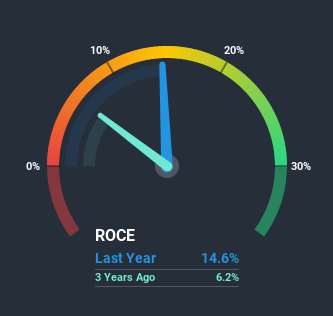We Like These Underlying Return On Capital Trends At Netflix (NASDAQ:NFLX)
What are the early trends we should look for to identify a stock that could multiply in value over the long term? Firstly, we'd want to identify a growing return on capital employed (ROCE) and then alongside that, an ever-increasing base of capital employed. If you see this, it typically means it's a company with a great business model and plenty of profitable reinvestment opportunities. Speaking of which, we noticed some great changes in Netflix's (NASDAQ:NFLX) returns on capital, so let's have a look.
Return On Capital Employed (ROCE): What is it?
For those that aren't sure what ROCE is, it measures the amount of pre-tax profits a company can generate from the capital employed in its business. Analysts use this formula to calculate it for Netflix:
Return on Capital Employed = Earnings Before Interest and Tax (EBIT) ÷ (Total Assets - Current Liabilities)
0.15 = US$4.6b ÷ (US$39b - US$7.8b) (Based on the trailing twelve months to December 2020).
Thus, Netflix has an ROCE of 15%. That's a relatively normal return on capital, and it's around the 14% generated by the Entertainment industry.
See our latest analysis for Netflix
Above you can see how the current ROCE for Netflix compares to its prior returns on capital, but there's only so much you can tell from the past. If you'd like, you can check out the forecasts from the analysts covering Netflix here for free.
What The Trend Of ROCE Can Tell Us
We like the trends that we're seeing from Netflix. Over the last five years, returns on capital employed have risen substantially to 15%. The company is effectively making more money per dollar of capital used, and it's worth noting that the amount of capital has increased too, by 371%. So we're very much inspired by what we're seeing at Netflix thanks to its ability to profitably reinvest capital.
In another part of our analysis, we noticed that the company's ratio of current liabilities to total assets decreased to 20%, which broadly means the business is relying less on its suppliers or short-term creditors to fund its operations. This tells us that Netflix has grown its returns without a reliance on increasing their current liabilities, which we're very happy with.
The Bottom Line
A company that is growing its returns on capital and can consistently reinvest in itself is a highly sought after trait, and that's what Netflix has. And a remarkable 470% total return over the last five years tells us that investors are expecting more good things to come in the future. In light of that, we think it's worth looking further into this stock because if Netflix can keep these trends up, it could have a bright future ahead.
Like most companies, Netflix does come with some risks, and we've found 1 warning sign that you should be aware of.
While Netflix isn't earning the highest return, check out this free list of companies that are earning high returns on equity with solid balance sheets.
This article by Simply Wall St is general in nature. It does not constitute a recommendation to buy or sell any stock, and does not take account of your objectives, or your financial situation. We aim to bring you long-term focused analysis driven by fundamental data. Note that our analysis may not factor in the latest price-sensitive company announcements or qualitative material. Simply Wall St has no position in any stocks mentioned.
Have feedback on this article? Concerned about the content? Get in touch with us directly. Alternatively, email editorial-team (at) simplywallst.com.

